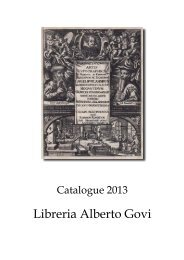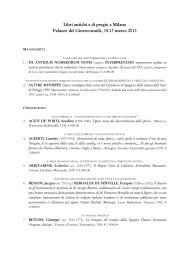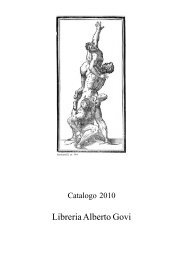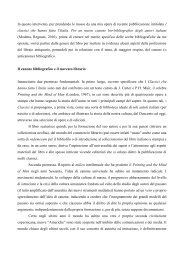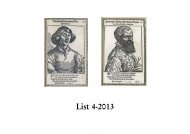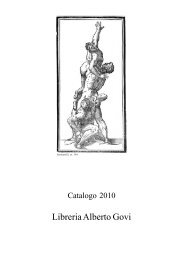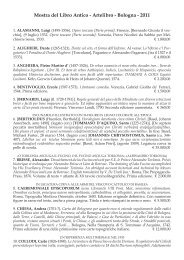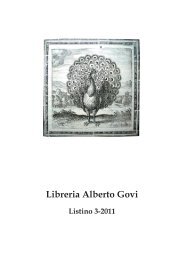List 1-2013.pdf - Libreria Antiquaria Alberto Govi
List 1-2013.pdf - Libreria Antiquaria Alberto Govi
List 1-2013.pdf - Libreria Antiquaria Alberto Govi
Create successful ePaper yourself
Turn your PDF publications into a flip-book with our unique Google optimized e-Paper software.
“t h e m o s t u n i q u e – a n d p r o b l e m a t i c – c a s e o f f e m a l e i m p e r s o n i f i c a t i o n” (m.k. ra y)<br />
13. [LANDO, Ortensio (ca. 1512-1556)]. Lettere di molte valorose donne, nelle quali chiaramente appare non esser ne<br />
di eloquentia ne di dottrina alli huomini inferiori. Venezia, Gabriel Giolito de’ Ferrari, 1548 (in fine: 1549).<br />
8vo; 19 th century half vellum over boards, manuscript title on spine; 161, (3, the last is a blank) ll. Printer’s device on the title-page and at<br />
the end. Although the running title says “Libro primo”, a second book was never published. A nice copy.<br />
FIRST EDITION, first issue. The volume opens with an anonymous dedication to Sigismondo Rovello, English ambassador to Venice<br />
(dated Venice, October 23). Lando’s name appears only in the final advice to the reader by Bartolomeus Pestalossa Rhetus (l. X1v).<br />
“Perhaps the most unique – and problematic – case of female impersonification among sixteenth century letterbooks is the Lettere<br />
di molte valorose donne, nelle quali chiaramente appare non esser ne di eloquentia ne di dottrina alli huomini inferiori, an anthology of<br />
women’s letters published anonymously by Ortensio Lando in 1548. The first book of ‘women’s’ letters (either genuine or male-authored)<br />
to follow in the wake of Aretino’s ground-breaking epistolario, the Valorose donne were also the only anthology of the period to consist<br />
entirely of letters exchanged between women. Comprising 253 letters on subjects from marriage and children to literature and religion, the<br />
Valorose donne are unconventional in another sense as well, for they constitute a particularly flamboyant case of epistolary ventriloquism<br />
in which Lando, a lover of masquerade and paradox, disguises himself in the supposed letters of 181 different women. Varyingly polemic,<br />
reproving, instructive, playful, and even comic, the Valorose donne are a seemingly unrelated melange of epistles threaded with citations<br />
from classical and modern authorities, on a range of subjects from the serious to the absurd. The majority of letters bear the names of women<br />
who really existed, but some women are almost certainly invented by Lando, creating juxtaposition of real and imagined epistolary<br />
characters that adds to the anthology’s illusionary, deceptive structure. Dates, as well as references to specific places or events, are vague,<br />
and most of the letters appear to exist more for the sake of making a point than as part of any actual epistolary exchange, a facet intensified<br />
by the apparent lack of an internal logic to the letters. No one thematic thread recurs with enough frequency to offer an immediate key for<br />
interpretation or a unifying framework for the anthology. Rather, it is difficult to discern a dominant point of view, for, in typical Landanian<br />
fashion, one letter’s argument is contested by another’s. The complicated issue of authorship raised by the extensive impersonification,<br />
along with the seemingly unorganized and often contradictory content of the letters themselves, render the Valorose donne a text that defies<br />
easy categorization or analysis” (M.K. Ray, Female Impersonification: Ortensio Lando’s ‘Lettere di molte valorose donne’, in: “Writing<br />
Gender in Women’s Letter Collections of the Italian Renaissance”, Toronto, 2009, pp. 45-46).<br />
“Le donne valorose entrano nella storia della letteratura attraverso un’impostura e con quella ‘canina eloquenza’ che l’autore, Ortensio<br />
Lando, attribuiva burlescamente alla propria scrittura… Primo vistoso segnale del gioco letterario è il nome di una delle destinatarie:<br />
Clara Burla. L’autore stesso avverte della simulazione: non veste i panni del segretario o del ghost-writer… Se ogni discussione sull’antologia<br />
giolitina deve inevitabilmente affrontare il problema della paternità landiana dell’opera, uno dei tanti nodi da chiarire rimane quello<br />
- 36 -



